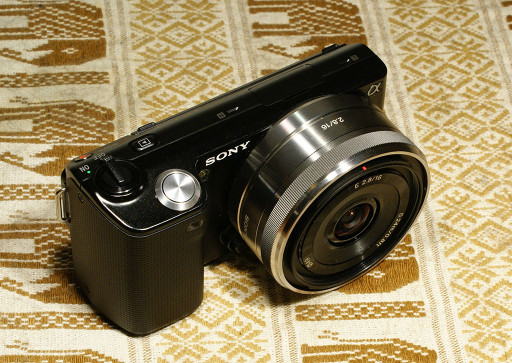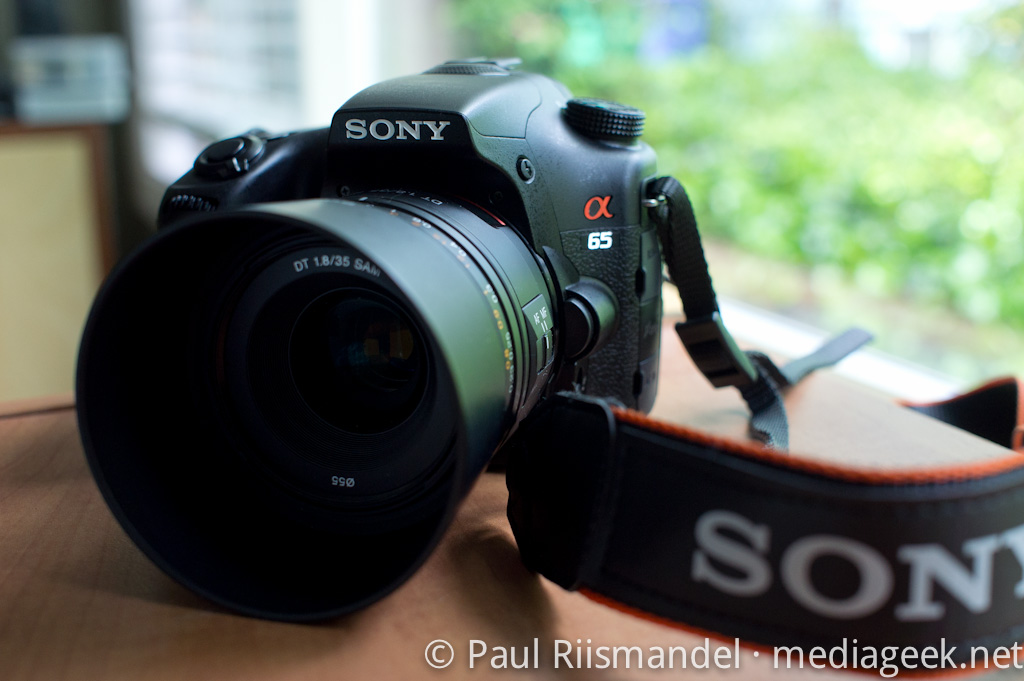It is not at all surprising that I bought a camera. It’s something I do every so often.
Reading gadget and technology sites, photography blogs and the like makes me feel like I don’t buy a lot of tech toys or upgrade my tech all that often. Then I compare myself to friends and other members of the general public and it seems like for every one new camera a typical person buys, I buy three or four. Perspective, indeed.
I bought a Sony Alpha 65 (officially, SLT-A65), which is actually only my second digital SLR. My first was also Sony’s first, the Alpha 100 (or a100), purchased a near camera-eternity ago in 2006. dSLRs have come a long way in eight years. The a100 doesn’t take video, has a whopping 10 megapixels and uses compact flash cards. Still, it’s a camera I used in the month before buying the a65.
Now, at this point I have likely given the impression that I have barely purchased any digital cameras since 2006. That is false. I simply haven’t bought a dSLR. And even that’s a little misleading.
I bought another interchangeable lens digital camera four years ago, in 2010, also a Sony: the NEX–5. The NEX has served as my primary cam, since it has the same size sensor as most dSLRs, but is much more modern than the a100, with 14 megapixels, video capability, and the ability to work in low light that far surpasses that first generation Alpha. It isn’t a dSLR because it doesn’t have a proper viewfinder which shows you a view through the lens. Instead it just has a rear LCD which is always on, making it a hybrid between a dSLR and a compact point & shoot, but with a much bigger sensor and better quality images.

So, essentially, I’m on a four-year upgrade cycle on my main digital cameras. Compared to professional photographers and hardcore amateurs who need to stay up to date–and who also wear their stuff out more quickly–this is slow turnover. Compared to many other folks, I upgrade a lot. The difference is those who update less frequently tend not to blog or tweet about it. Though, maybe I should search for this tweet on December 31: “Nope, didn’t buy a new dSLR this year either.”
Both the a100 and the NEX–5 were new models when I bought them. They were also the first models of their type. The a100 was Sony’s very first dSLR. The NEX–5 was the company’s first so-called “mirrorless” interchangeable lens camera.
The a65 is neither a new model, nor the first of it’s type. In fact, it came out nearly two years ago. And it’s not exactly a dSLR, either, even though it looks like one. In an SLR you see through the lens via a mirror that reflects the image up to a viewfinder. This mirror flips up out of the way when you take a picture. The a65 has a viewfinder, but it’s actually a tiny video monitor which is always on. You can also use the monitor on the back of the camera. It takes my Sony A-mount dSLR lenses, so it is definitely an upgrade from my a100, even if it’s a slightly different camera. As it is, Sony doesn’t make any new true dSLRs anyway.
I started thinking about a new dSLR earlier this year after completing a photo project with my NEX–5. It’s a great camera, but the lack of a real viewfinder was a pain during a number of outdoor shoots with bright sun. The back screen gets washed out in bright light, making it difficult to frame and focus.
The NEX’s chief advantage was also a bit of a liability. I love this camera because it is small–only a little bigger than most point-and-shoots. But it’s size means that it really isn’t practical to put bigger lenses on it, especially big zooms. Using the NEX for some serious projects I kept wishing that it were an SLR. Of course, I could have used my a100, but in some conditions its low light capabilities aren’t nearly as good, and it doesn’t take video.
I wanted a newer dSLR, but I also didn’t want to spend a ton of money. So I started looking around at used models, figuring that I could save several hundred bucks and still get a camera that was a little more advanced than either the a100 or NEX–5. Just when I started to narrow in on the a65 and another model, Sony ran an “instant rebate” on the a65 which made a new one barely $100 more than a used one. Fate, it would seem, intervened.
So I bit.
I’ve had the a65 for a few weeks now, and been out on a number of photowalks in that time. So far, I have absolutely no regrets. Especially with newer Sony lenses, the autofocus is wickedly fast and accurate, letting me frame and fire off shots unexpectedly faster than I could with the a100 or NEX–5. It’s also quieter than those two.
The a65 has a lot more resolution, too. 24 megapixels. Which is way more than I thought I’d ever need. Just playing around I’ve been amazed at the kind of fine detail I’m finding in pictures; things that will never show up in most reasonable sized prints, that you’ll only see by pixel-peeping on a computer monitor.

The 65 is bascially Sony’s step-down from its so-called “prosumer” A77, whose replacement–the a77 II–was recently announced. Compared to the a77, the a65 is more plasticky, a little slower and not weather-sealed. But since I’m not too hard on my cameras I don’t find that a problem. While I’ve taken photos as part of my job, it was always with my employer’s gear, not mine. If I start taking a ton of paid shoots, then maybe I’ll need something sturdier. Of course, ostensibly I’d have the captial for it, too.
Even with two-year-old technology I’m very satisfied with my a65, and I’m looking forward to using it more.
As many readers may be aware, choosing a brand of camera is bit like choosing a religion. Camera geeks take this shit seriously. I’m certain that a competing model from Canon or Nikon performs at least as well, maybe better in some respects. I’ve used models from other companies in other circumstances with no complaints. I happen to have enough Sony lenses that the prospect of having to start over is not desirable. Plus, I like that Sony puts stabilitzation in the camera body, meaning that I get image stability with every lens I use, not just the special, more expensive VR lenses. Finally, I’m finding that I really like having the LCD viewfinder rather than the optical view through the lens. To me it’s clear and sharp, the data displays are easier to read, and it tells you what’s in focus better than my eye can judge on it’s own.
I’m not saying you should buy a Sony dSLR. There are a lot of good reasons to buy a Canon or Nikon… or Olympus, Panasonic, Pentax, Fuji… My only advice is figure out what works for you, and stick with it.
Some folks really enjoy trying new cameras and lenses and don’t mind swapping out between systems regularly. Others are collectors, willing to amass a cabinet full of camera bodies and lenses from a dozen manufacturers. It’s similar to how some guys will trade in cars every two years for a new model, or fill a couple of garages with them. If that’s what makes your motor run, great! Otherwise, if you find that you like your Nikon, Canon or Sony and get some lenses that work for you, I advise sticking with that brand. There will always be a feature that looks enticing. But unless you’re making your living from photography and staying at the front of the pack, a little patience usually pays off. These camera companies pay attention to each other, and will rip each other off in time if you wait.
This isn’t strictly a photography blog. But some of my most popular posts are about my NEX–5. So I’ll post updates of how things are going with my new, though apparently discontinued, Alpha 65 as I get more experience with it.
